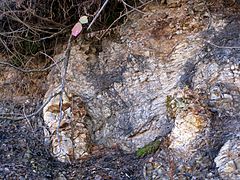| Rincon Formation | |
|---|---|
| Stratigraphic range: Miocene | |
 Weathered outcrop of the Rincon Formation, Sycamore Canyon, Santa Barbara, California. | |
| Type | sedimentary |
| Underlies | Monterey Formation |
| Overlies | Vaqueros Formation |
| Thickness | 500 to 1700 feet[1] |
| Lithology | |
| Primary | shale |
| Other | siltstone, mudstone, with minor sandstone beds |
| Location | |
| Region | Coastal southern California |
| Country | United States |
| Type section | |
| Named for | Rincon Mountain (east slope, Los Sauces Canyon), Ventura County |
| Named by | Kerr, 1936 [2] |
The Rincon Formation (or Rincon Shale) is a sedimentary geologic unit of Lower Miocene age, abundant in the coastal portions of southern Santa Barbara County, California eastward into Ventura County. Consisting of massive to poorly bedded shale, mudstone, and siltstone, it weathers readily to a rounded hilly topography with clayey, loamy soils in which landslides and slumps are frequent. It is recognizable on the south slopes of the Santa Ynez Mountains as the band at the base of the mountains which supports grasses rather than chaparral. Outcrops of the unit are infrequent, with the best exposures on the coastal bluffs near Naples, in the San Marcos Foothills, at the Tajiguas Landfill, and in road cuts. The geologic unit is notorious as a source of radon gas related to its high uranium content, released by radioactive decay.[3]
- ^ Dibblee, Thomas. Geology of the central Santa Ynez Mountains, Santa Barbara County, California. Bulletin 186, California Division of Mines and Geology. San Francisco, 1966. 42
- ^ Dibblee (1966), 28
- ^ City of Goleta, California. Background Report #16. Geology/Geologic Hazards. March 19, 2004. p. 2, 4, 11. Accessed at www.cityofgoleta.org/Modules/ShowDocument.aspx?documentid=649